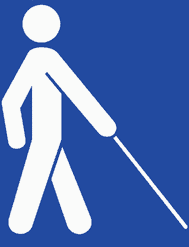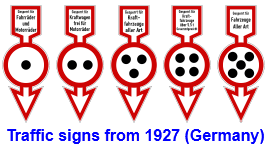Logos / signs for blind people
Blind logos / blindness symbols / blind signs / blind mark / symbol for the blind / sign for the blind:






Blind logos large / blind symbols print (graphic)
As traffic-safety-sign for the
- the white cane (long stick)
- the white guide harness of a guide dog
- the yellow handicapped armband (three black dots)
The white cane was invented in February 1931 by Madam Guilly d'Herbement

A good idea from the Czech Republic and England: The

Only about 2% of the blind (in Germany) have a guide dog.

Different armbands - only the left (3 black dots) is valid in Germany as a traffic-safety-sign.
The most frequently used traffic-safety-sign by blind people
The yellow armband with the three black dots is also valid

The yellow armband was introduced after the First World War,

The white cane did not exist yet, but

The three black dots therefore have nothing to
Meaning of the sign with the

Today, the stereotypical symbol of the three black dots

or so

(Conceivable is the use of



